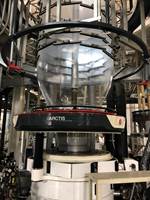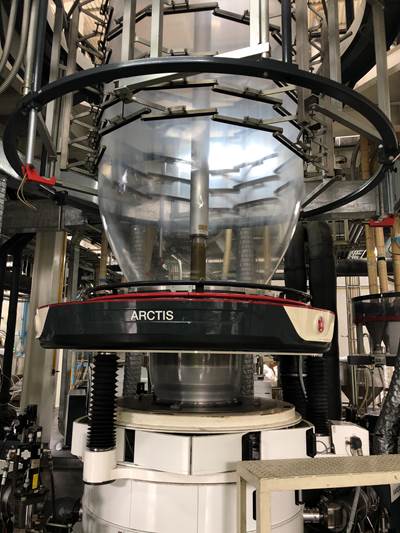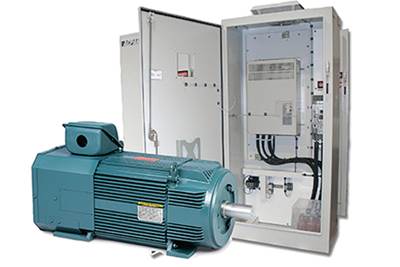Programmable Logic Controllers (PLCs) are plant-floor computers that go back to the 1970s, when they ushered in a new area in industrial automation, now known as Industry 3.0. Initially, PLCs were a replacement for relay panels used for machine control. Over the years, they have evolved to include advanced programming functions that allows the engineering designer to create solutions for every type of complex machine process encountered in manufacturing today.
Astonishingly—and unfortunately—many of the extruder control systems in use today do not take advantage of this advance in technology and still operate as they did more than 40 years ago. As other industries forge ahead with concepts of Industry 4.0, many extrusion processors grapple with how to justify upgrading their existing control systems.
Through their inaction they are choosing to accept the risks associated with operation of these obsolete control systems. These risks include greater downtime, increased scrap, machine damage and more importantly a risk to the health and welfare of their employees. This article discusses the problems and risks associated with maintaining the status quo and ignoring the need to make a change to improve machine control.

An updated extrusion control system should be easier to use, self-diagnostic, and provide you with process data. All photos: Integrated Control Solutions
Problem: It Does Not Apply to Me
Risk: Pride Comes Before the Fail
The first mistake management makes is believing that whatever new idea being presented applies to someone else...not them. But it almost always indeed does apply to them. Many plant managers are unaware of the components used within machine panels, let alone the idea of their obsolescence and the risk that it may pose. In addition, most extrusion operations have never even bothered to perform risk assessments on their machinery to help identify potential problems with their existing control systems.
Problem: Baby Boomers are Retiring
Risk: Expect More Downtime
With the pandemic causing unprecedented spikes in unemployment, many Baby Boomers have chosen to retire. A Pew Research Report found that in the third quarter of 2020, approximately 28.6 million Boomers (born between 1946 and 1964) retired, which is 3.2 million (12.6%) more than reported in the same quarter in 2019.
The maintenance and upkeep of older machines within plastic processing plants has been handled, by and large, by the Boomers. This generation grew up working on their cars and have a strong mechanical aptitude and have used these skills in troubleshooting and repair of old production machinery for years. After they retire, some have been coerced to rejoin the workforce to keep machinery running, but that is a short-term solution.
Most extrusion operations have never even bothered to perform risk assessments on their machinery to help identify potential problems with their existing control systems.
In some cases, Boomers in maintenance jobs have used a PLC to develop a system better than the one that was previously installed. Unfortunately, the software in many of these upgrades is rudimentary and has no diagnostics or protective features; and, in many cases, the Boomers are the only ones that know how it works. The lesson here is that it is not as much about the PLC as it is the software it contains.
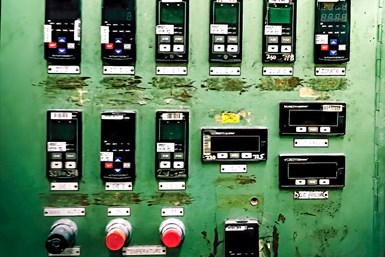
Older extrusion-control systems often do not have important features such as runaway heat protection, which can result to operators getting burned, or fires.
Millennials have a different skill set than Baby Boomers. They are more computer savvy and spend much of their time on the internet. They expect a symbiotic relationship between man and machine. If trouble were to arise, they would expect an error message explaining where the problem is and how to repair it. This is far from what really happens with older extrusion lines. On one occasion a company was considering an upgrade and employed a Millennial to work with the older maintenance supervisor for the success of the transition. The company ultimately decided not to go forward with the project; the supervisor retired and the Millennial resigned.
Problem: Supply Chain Interruption
Risk: Expect Significant Downtime
For years, managers have delayed upgrading older lines, essentially “kicking the can down the road,” waiting for a perfect time for an upgrade. Unfortunately, today’s supply-chain shortages have created a huge problem for those who think this way. Anticipating upcoming shortages, many industrial distributors have increased orders to try to outpace demand. This has resulted in a significant backlog for industrial control manufacturers and extended lead times—as long as 10-13 months on some products.
In response to this, managers have decided to “wait until this is over before we make a decision.” Poor planning on upgrading extrusion lines by processors will certainly lead to significant downtime and potentially result in the necessity of your parts supply being those robbed internally from other running lines. Therefore, planning requires taking action well before failure to avoid costly downtime—not “waiting for things to get better.”

With supply-chain delays, going out to a year in some cases, running a profitable line with older or obsolete parts is placing finances at great risk.
Problem: Fewer Skilled Workers
Risk: Expect More Damage and Scrap
The labor shortage created by the pandemic has almost created a “we’ll take what we can get” approach when it comes to extrusion operators. For those plants operating 24/7, it is painfully obvious by looking at what happens on the third shift that is is a poor strategy. Inexperienced operators are common in the workforce. One day they may be operating an extrusion line and the next day they are working in retail for $1 more an hour.
To inexperienced operators, all the meters and gauges can be intimidating and make them feel they are in the cockpit of a World War II bomber, about to fly a mission with little training. It’s easy to understand why they may not do everything precisely to start up a line or keep it running. These situations can cause significant damage to machinery, like locking up or breaking a screw or damaging a gearbox. In addition, improper temperature settings will result in costly scrap.
Poor planning on upgrading extrusion lines will certainly lead to significant downtime.
A PLC with proper software will prevent many of these situations from occurring. Features such as Cold Zone Inhibit, Screw Break Prevention and Restricted Operator are available from manufacturers.
Problem: No Protective Features
Risk: Expect someone to get Hurt!
Of all the issues listed, this is perhaps the most concerning. Older extrusion lines that do not utilize PLCs with the proper software have no protective features. Our company has upgraded three extrusion lines over the last five years that caught fire because they had no runaway-heater protection. In extreme cases, I have witnessed direct violations of the National Electric Code (NEC)—those machines should not be in operation and pose a potential to personal injury. In such situations, inaction is actually taking action in accepting liability for the associated risk. Employers may be held liable if there is a failure to act on equipment that is not running properly, or if it is found to not pass inspection, resulting in negligence claims; in some cases, it is a legal obligation to make sure equipment is in working order and safe to operate.
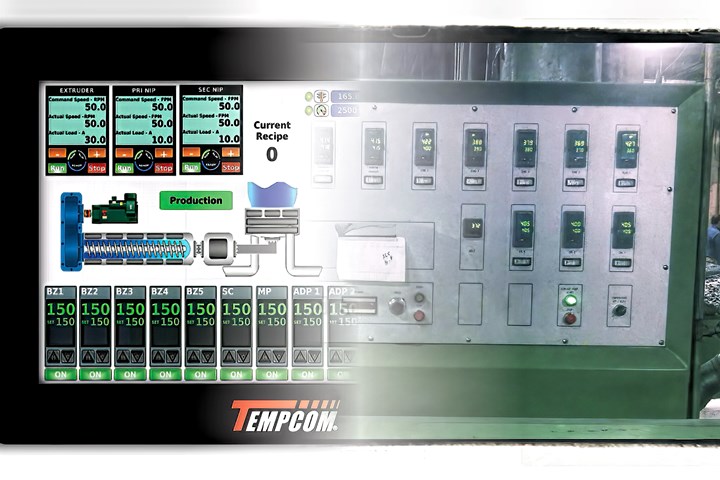
Upgraded extrusion-control systems should be more intuitive to even an unskilled operator and require minimal training to run the line.
If the problems and risks have motivated your company to take action, please use caution if you attempt to perform this in-house or with a local systems integrator. Again, the software inside the PLC is more important than the PLC itself. Therefore, unless you are extremely thorough in documenting the protective features required to avoid all of these problems and risk, it is better to work with a company that is familiar with the extrusion process and has installations around the country.
ABOUT THE AUTHOR: Scott Barlow is the CEO of Integrated Control Technologies, which specializes in aftermarket drive and control upgrades for extruders. He has written a white paper that was published by the Society of Plastic Engineers on The Energy Differences of DC and AC Drives and Motors on Extruders.” Barlow has spoken at many technical conferences and has performed over 500 energy studies on extruders. Contact: 972-906-7445; sbarlow@integratedcontroltech.com; integratedcontroltech.com.
Related Content
How Screw Design Can Boost Output of Single-Screw Extruders
Optimizing screw design for a lower discharge temperature has been shown to significantly increase output rate.
Read MoreRoll Cooling: Understand the Three Heat-Transfer Processes
Designing cooling rolls is complex, tedious and requires a lot of inputs. Getting it wrong may have a dramatic impact on productivity.
Read MorePart 2 Medical Tubing: Use Simulation to Troubleshoot, Optimize Processing & Dies
Simulation can determine whether a die has regions of low shear rate and shear stress on the metal surface where the polymer would ultimately degrade, and can help processors design dies better suited for their projects.
Read MoreReduce Downtime and Scrap in the Blown Film Industry
The blown film sector now benefits from a tailored solution developed by Chem-Trend to preserve integrity of the bubble.
Read MoreRead Next
Film Processor Boosts Line Performance with Air-Ring Retrofit
Air-ring upgrade results in output gains up to 23% for leading film processor in Indonesia. Gauge uniformity also improved.
Read MoreSwitch to AC Drives & Save Energy, Maintenance Costs
Smaller, cooler AC packages can be retrofitted to existing lines to slash energy use and maintenance costs.
Read MoreMaking the Circular Economy a Reality
Driven by brand owner demands and new worldwide legislation, the entire supply chain is working toward the shift to circularity, with some evidence the circular economy has already begun.
Read More

